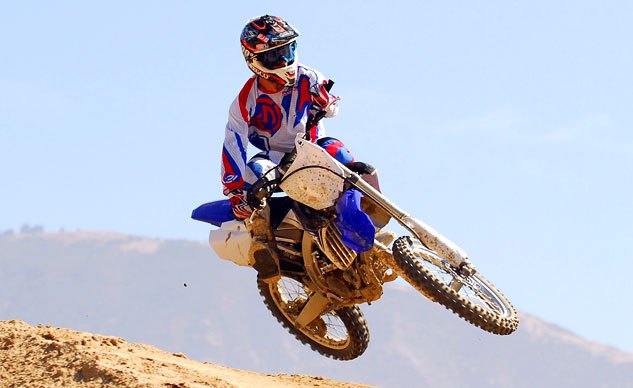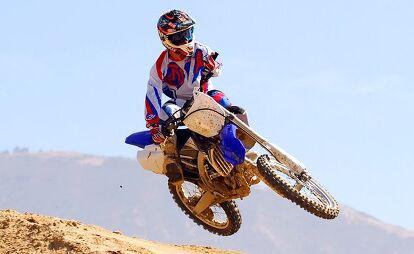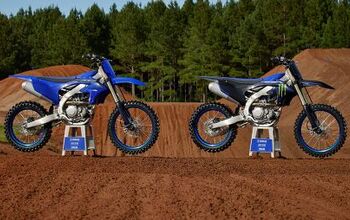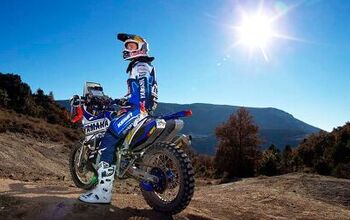2014 Yamaha YZ250F First Ride
Dramatic performance increase from an all-new reverse-cylinder engine
With an all-new motor and chassis layout the 2014 YZ250F represents the pinnacle of Yamaha motocross design, and after testing it this week, we think it may have even surpassed its super-powered YZ450F sister as the best motocross machine in the Yamaha family.
With unchanged or slightly revised 250s from Honda, Kawasaki, KTM and Suzuki for 2014, the YZ250F may also be poised to reclaim best 250cc motocross bike honors.
Our impressions of the YZ250F were made during a brief three-hour intro on a perfectly groomed track at Glen Helen Raceway in San Bernardino, California. To get the most out of the machine in that short of a timeframe, we once again enlisted the services of professional off-road racer Ryan Abbatoye, who also happens to be a heck of a fast motocross rider.
It’s also worth mentioning that our First Ride was conducted aboard a “pre-production” machine and not a regular production unit, but Yamaha officials assure us that what we rode is what you’ll get. Each manufacturer may have its own definition of the term, but for Yamaha pre-production simply means the first 50 vehicles (or so) to be run on the regular production line in order to check the quality and consistency of the line itself. All of the vehicle specs and settings are already set beforehand, so it should perform identical to what the customer will be purchasing when the YZ250F hits showroom floors this October.
It took only a few quick laps aboard the YZ250F for us to realize that Yamaha’s all-new fuel-injected DOHC wet-sump engine delivers power and performance that’s a quantum leap over the 2013 model. For starters, its throttle response is amazingly crisp, thanks to its new Keihin 44mm throttle body that utilizes a 10-hole injector (rather than the 12-holer quoted in its June press intro) to better atomize the intake charge.
The 3D-mapped system uses data from multiple sensors, reading throttle position, intake pressure, intake air temperature, crankshaft rpm and even the coolant temperature to signal the ECU to adjust the fuel mixture. It’s a night and day difference over the carbureted unit, as our test bike delivered ideal response at all throttle settings and regardless of engine load at Glen Helen.
But it takes more than just crisp response to get around the track. Unlike 450cc machines, which already have an excess of horsepower, squeezing every last fraction of a pony is vital in the 250cc class. Yamaha engineers have delivered a muscle motor, with a strong bottom end punch that transitions to a clean midrange and finishes off with a potent top-end charge. That allowed Abbatoye to blast out of Glen Helen’s tighter corners and fly over its huge tabletop jumps with authority. Abbatoye also said that he was able to pull third gear more easily than any stock 250cc four-stroke he’s ever ridden.
Negotiating the track’s mountainous elevation changes failed to elicit a wheeze out of the stout motor.
The Yamaha engine is surprisingly meaty for a 250. Yamaha engineers worked to improve the YZ250F’s mid-to-high rpm power while mitigating the loss – or at least the feeling of a loss – in low-end torque. Effectively, they moved backward to move forward, designing the new motor with a forward-positioned (reversed) cylinder head and rear-inclined cylinder just like the YZ450F’s. This design reverses the intake and exhaust ports and allows the intake ports to be symmetrical, which provides straightest possible shot into the combustion chamber, improving power output. The cylinder itself is also inclined toward the rear of the chassis, which offsets the connecting rod so that it is more vertical at the moment of greatest combustion force and minimizes piston-induced drag against the cylinder wall. Less drag equals more power, and Abbatoye could definitely feel that increased power on the track.
The YZ250F’s cylinder head also uses four titanium valves rather than five to simplify its top-end layout. Its 77.0 x 53.6mm bore and stroke and 13.5:1 compression ratio are the same as the 2013 model, but the 2014 features a new lightweight forged two-ring piston that is cooled by an oil spray jet for better heat management, along with new cam profiles, a new ECU, a new carburized crankshaft designed for better durability, a newly designed five-speed transmission and a stronger clutch.
Clutching and shifting have never been a real issue with the YZ250F, and the 2014’s transmission shifts every bit as smoothly and consistently as the old bike’s. And thanks to the stronger engine output, Abbatoye said that you don’t have to tap dance on the shifter nearly as much to keep the 250F in the meat of its power. That should equate to faster lap times on any track.
The 2013 YZ250F was renowned for its easy and predictable handling. So while the YZ250F’s new Bilateral Beam aluminum chassis uses the same dimensions as the 2013 chassis, it is now 14mm narrower at its widest point to give it a slimmer and more compact feel.
Mass centralization was also a priority, so the 250F’s list of changes includes a new exhaust pipe design that wraps the head pipe around the 250F’s cylinder and a muffler that’s repositioned 186mm further forward behind the side panel, lower and closer to the middle of the chassis to shrink the mass.
The unique engine layout allowed flexibility in placing other components. The 250F’s 2.1-gallon fuel tank is now more rearward and lower in the chassis. So low, in fact, that the fuel filler is now located below the frame spars and is accessed via a removable section at the front of the seat.
Abbatoye praised the YZ’s cornering ability, straight-line stability and overall chassis feel of the YZ250F. The overwhelming sense is one of extreme lightness with a good front-end feel that makes railing corners and exploding berms a blast. It also tracks through rutted turns with remarkable precision. And even with the YZ250F’s light-steering chassis, it exhibits good stability at higher speeds. And its feathery feel gives it excellent maneuverability in the air, making scrubs and whips over jumps an afterthought – for experts, anyway.
The suspension is one area where we’re glad Yamaha hasn’t pushed the envelope like some of its competition, as the 250F’s KYB fork with Speed-Sensitive System valving system still incorporates one coil spring per fork leg. The fork stanchions have been redesigned to optimize their thickness, and are now clamped in a rubber-mounted triple clamps. Out back is a fully adjustable KYB shock mated to the YZ’s aluminum swingarm via rising-rate shock linkage. Suspension travel is 12.2” up front and 12.4” out back.
For off-road use, we still think coil springs are the better way to go, and the YZ250F really doesn’t appear to give up anything to its supposedly higher-tech competition (air forks and shocks were actually used in the 1970s!) on the track. At Glen Helen, Abbatoye found the fork to his liking. Some nasty ruts on the track tasked the high-speed absorption capabilities of the fork and the shock. Both passed with flying colors while also providing plenty of cushion for landings from numerous skyshots over the jumps. And we never touched an adjustment knob all day. Impressive stuff.
We also enjoyed the YZ250F’s ergos for their slim yet comfortable layout. The combination of a good handlebar bend, slim and flat seat layout and wide, well-placed footpegs make scooting forward for a turn or climbing around on the machine easy. Abbatoye said that the only thing he might change are either the grips or the throttle housing height to avoid contact with the rider’s thumb, which can cause blisters to the knuckle closest to the wrists.
But that’s a small price to pay for the amount of performance the 2014 YZ250F delivers. It’s fast, it handles like a dream, and its suspension is well-sorted. And speaking of small prices, the 2014 YZ250F may be a quantum leap over the 2013 model, but at $7490 its retail price is only $200 more. Sounds like a bargain to us.
More by Scott Rousseau












































![2010 Yamaha YZ250F Preview [video]](https://cdn-fastly.motorcycle.com/media/2023/05/31/11737126/2010-yamaha-yz250f-preview-video.jpg?size=350x220)
















Comments
Join the conversation